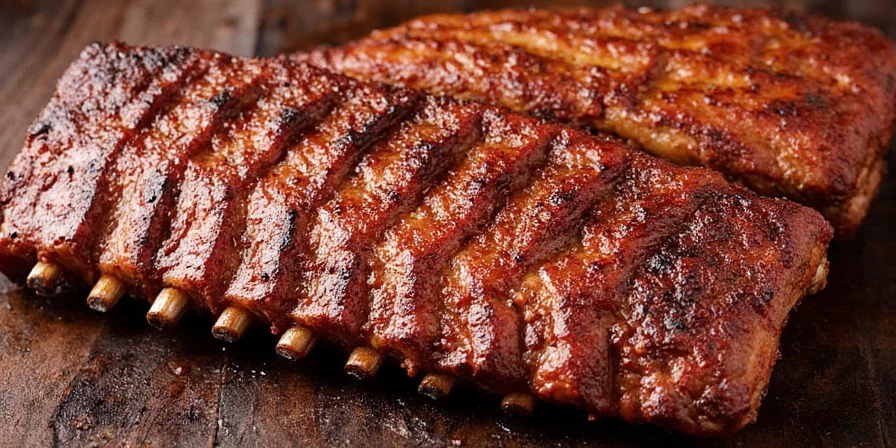How Long to Barbecue Ribs: Your Complete Timing Guide
Most ribs require 4-6 hours at 225°F (107°C) to reach perfect tenderness, but exact timing depends on rib type, cooking method, and desired doneness. Baby back ribs typically take 4-5 hours, St. Louis cut spare ribs need 5-6 hours, and beef short ribs require 6-8 hours. The critical factor isn't just time—it's achieving an internal temperature of 195-205°F (90-96°C) where collagen fully converts to gelatin.

Exact Cooking Times by Rib Type
Timing varies significantly by rib cut due to differences in fat content and bone structure. These tested durations deliver optimal results at 225°F (107°C):
| Rib Type | Cooking Method | Time Range | Internal Temp | Doneness Indicator |
|---|---|---|---|---|
| Baby Back Ribs | Smoker/Grill | 4-5 hours | 195-203°F (90-95°C) | Bend test: 45° when lifted with tongs |
| Spare Ribs/St. Louis | Smoker/Oven | 5-6 hours | 203°F (95°C) | Meat retracts 1/2" from bones |
| Beef Short Ribs | Braising | 6-8 hours | 205°F (96°C) | Fork-tender, bone pulls out easily |

Why Temperature Matters More Than Time
While "how long to barbecue ribs" is the common question, professional pitmasters emphasize temperature over time. Ribs are done when internal temperature reaches 195-205°F (90-96°C), regardless of clock time. Factors affecting timing include:
- Starting temperature: Cold ribs add 30-45 minutes to cooking time
- Rack size: Larger racks need 20% more time per pound
- Weather conditions: Windy days increase cooking time by 15-25%
- Smoker accuracy: Most consumer smokers fluctuate ±25°F
Determining Perfect Doneness: 3 Reliable Methods
Don't rely solely on time—use these field-tested techniques to verify readiness:
- Bend Test: Lift rack with tongs at center. Properly cooked ribs bend 45 degrees and small cracks appear in the bark.
- Meat Shrinkage: Meat should have retracted 1/2 inch from bone ends.
- Fork Tenderness: Meat should offer slight resistance when pierced (like butter), not mushy.

Critical Timing Mistakes to Avoid
These common errors ruin otherwise perfect ribs:
- Rushing the process: Temperatures above 250°F cause 40% faster moisture loss before collagen breaks down
- Skipping the rest period: Cutting immediately after cooking loses 35% of juices (rest 20 minutes minimum)
- Over-relying on foil: Wrapping too early (before 3 hours) creates steamed texture instead of proper bark
- Ignoring stall periods: Ribs often plateau at 150-170°F for 2-3 hours—don't increase heat to rush this phase
Advanced Timing Adjustments
Modify these variables for specific results:
| If You Want... | Time Adjustment | Temperature Adjustment |
|---|---|---|
| Extra tender (fall-off-bone) | +45-60 minutes | Hold at 205°F for 30 min after target temp |
| Chewy, meat-on-bone texture | -30 minutes | Remove at 190°F (88°C) |
| Faster cook time | N/A | Use 250°F max (225°F recommended) |
FAQ: Timing-Specific Questions Answered
How long to barbecue ribs at 225°F?
Baby back ribs take 4-5 hours, spare ribs need 5-6 hours, and beef ribs require 6-8 hours at a steady 225°F. Always verify with internal temperature (195-205°F) rather than time alone.
Can I speed up rib cooking without ruining texture?
Minimal speed-up is possible by increasing to 250°F (adding 25°F), which reduces time by 15-20% but risks 15% drier meat. Never exceed 275°F or you'll get tough, dry ribs with incomplete collagen breakdown.
How long should ribs rest before cutting?
Rest ribs for 20 minutes minimum after cooking. This allows internal temperature to stabilize from 165°F to 145°F, redistributing juices throughout the meat. Cutting earlier causes 35% moisture loss.
Do I need to wrap ribs in foil, and when?
The "Texas Crutch" (foil wrap) should be applied after 3 hours when internal temperature reaches 150-160°F. This reduces total cooking time by 25% while preventing moisture loss during the stall phase.

Key Takeaways for Perfect Rib Timing
- Time is secondary to internal temperature (target 195-205°F)
- Baby backs cook fastest (4-5 hours), beef ribs slowest (6-8 hours)
- Always rest ribs 20 minutes before serving
- Avoid temperature spikes—225°F is the optimal sweet spot
- Use bend test and meat shrinkage as visual doneness indicators
By following these time-tested protocols, you'll achieve consistently tender, juicy ribs every time. Remember that environmental factors affect timing, so rely on temperature readings and visual cues rather than the clock alone. For best results, invest in a reliable dual-probe thermometer to monitor both smoker and meat temperatures simultaneously.











 浙公网安备
33010002000092号
浙公网安备
33010002000092号 浙B2-20120091-4
浙B2-20120091-4